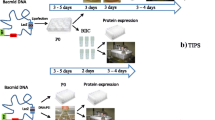Abstract
The baculovirus expression vector system was employed to produce human apolipoprotein E and β-galactosidase in order to study the effect of multiplicity of infection on secreted and non-secreted recombinant protein production. Prior knowledge of the influence of other cell culture and infection parameters, such as the cell density at time of infection and the time of harvest, allowed determination of the direct and indirect influences of multiplicity of infection on recombinant protein synthesis and degradation in insect cells. Under non-limited, controlled conditions, the direct effect of multiplicity of infection (10−1−10 pfu/cell) on specific recombinant product yields of non-secreted β-galactosidase was found to be insignificant. Instead, the observed increased in accumulated product was directly correlated to the total number of infected cells during the production period and therefore ultimately dependent on an adequate supply of nutrients. Only the timing of recombinant virus and protein production was influenced by, and dependent on the multiplicity of infection. Evidence is presented in this study that indicates the extremely limited predictability of post-infection cell growth at very low multiplicities of infection of less than 0.1 pfu/cell. Due to the inaccuracy of the current virus quantification techniques, combined with the sensitivity of post-infection cell growth at low MOI, the possibility of excessive post-infection cell growth and subsequent nutrient limitation was found to be significantly increased. Finally, as an example, the degree of product stability and cellular and viral protein contamination at low multiplicity of infection is investigated for a secreted recombinant form of human apolipoprotein E. Comparison of human apolipoprotein E production and secretion at multiplicities of infection of 10−4−10 pfu/cell revealed increased product degradation and contamination with intracellular proteins at low multiplicities of infection.
Similar content being viewed by others
References
Brown M and Faulkner P (1975) Factors affecting the yield of virus in a cloned cell line of Trichoplusia ni infected with a nuclear polyhedrosis virus. Journal of Invertebrate Pathology, 26: 251–257.
Dougherty EM, Weiner RM, Vaughn JL and Reichelderfer CF (1981) Physical factors that affect in vitro Autographa californica nuclear polyhedrosis virus production. Applied and Environmental Microbiology 41(5): 1166–1172.
Lazarte JE, Tosi PF and Nicolau C (1992) Optimization of the production of full length rCD4 in baculovirus-infected Sf9 cells. Biotechnology and Bioengineering, 40: 214–217.
Licari P and Bailey JE (1991) Factors influencing recombinant protein yields in an insect cell-baculovirus expression system: multiplicity of infection and intracellular protein degradation. Biotechnology and Bioengineering, 37: 238–246.
Licari P and Bailey JE (1992) Modelling the population dynamics of baculovirus-infected insect cells: optimizing infection strategies for enhanced recombinant protein yields. Biotechnology and Bioengineering, 39: 432–441.
Maiorella B, Inlow D, Shauger A and Horano D (1988) Large scale insect cell culture for recombi nant protein production. Biotechnology, 6: 1406–1410.
Miller JH (1972) Experiment 48: Assay of β-galactosidase. pp. 352–355, in Experiments in Molecular Genetics. Cold Spring Harbour Press. Cold Spring Harbour, New York.
Miller LK (1988) Baculoviruses as gene expression vectors. Annual Reviews in Microbiology, 42: 177–199.
Murhammer DW and Goochee CF (1988) Scaleup of insect cell cultures: protective effects of Pluronic F-68. Biotechnology, 6: 1411–1418.
Nielsen LK, Smyth GK and Greenfield PF (1991) Hemocytometer cell count distributions: implications of non-poisson behaviour. Biotechnology Progress, 7: 560–563.
Nielsen LK, Smyth GK and Greenfield PF (1992) Accuracy of the endpoint assay for virus titration. Cytotechnology, 8: 231–236.
Peter CH, Wong K, Reid S, Greenfield PF and Nielsen L (1995) Low multiplicity infection of insect cells with recombinant Baculovirus (in press).
Power JF, Reid S, Radford KM, Greenfield PF and Nielsen LK (1994) Modelling and optimization of the baculovirus expression vector system in batch suspension culture. Biotechnology and Bioengineering. 44: 710–19.
Radford KR (1994). Characterisation of the effect of the bioprocess environment on the capacity of the baculovirus expression vector system for recombinant product expression. PhD thesis, Department of Chemical Engineering, The University of Queensland, Australia.
Radford KR, Reid S and Greenfield PF (1992) Improved production of recombinant proteins by the baculovirus expression system using nutrient enriched serum free media. pp. 297–303 in Vlak JM, Schlaeger EJ and Bernard AR (eds.), Baculovirus and Recombinant Protein Production Processes. Editions Roche, Basel, Switzerland.
Radford KM, Reid S and Greenfield PF (1995) Substrate depletion limits high cell density growth and recombinant product yields in baculovirus infected insect cells. (Submitted for publication).
Reed LJ and Muench H (1938) A simple method of estimating fifty percent endpoints. American Journal of Hygiene, 27: 493–497.
Schopf B, Howaldt MW and Bailey JE (1990) DNA distribution and respiratory activity of Spodoptera frugiperda populations infected with wild type and recombinant Autographa californica nuclear polyhedrosis virus. Journal of Biotechnology, 15: 169–186.
Author information
Authors and Affiliations
Rights and permissions
About this article
Cite this article
Radford, K.M., Cavegn, C., Bertrand, M. et al. The indirect effects of multiplicity of infection on baculovirus expressed proteins in insect cells: secreted and non-secreted products. Cytotechnology 24, 73–81 (1997). https://doi.org/10.1023/A:1007962903435
Issue Date:
DOI: https://doi.org/10.1023/A:1007962903435




